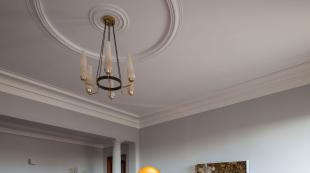Windmill from grinder gearbox. Do-it-yourself screwdriver generator video. Connection to electrical appliances
The ability to make a windmill from a used screwdriver has not only a theoretical, but also a practical basis, however, it is worth thinking about the end result.
The screwdrivers on sale today are quite powerful tools, its operating voltage when charging from an 18 volt battery, as a generator, can provide about 40-50 watts of power. Such power will allow you to light a couple of LED bulbs, this is when the wind blows, and if it's calm?
If we are talking about free time and recycling of trash, then it makes sense to deploy activities. If you need a working model, then a windmill made on the basis of an axial disk generator will generate more energy.
The process of turning a screwdriver into a home windmill is useful for the accumulation of general information in the field of physics, aerodynamics, electronics, which is also informative and interesting.
Components
All that can come in handy is the rotor from the same screwdriver.
Other missing parts will have to be bought, these are neodymium magnets of suitable dimensions, various rectifiers, converters, inverters and charge controllers.
Or find, for example, a chain reducer to correlate the speed of rotation of the rotor and generator.
Something to get - bearings for the blades.
The result is a wind generator with a capacity of 30-40 watts at a wind speed of 5-7 m/s.
But that's not all, you need to make your own hands:
- blades: from improvised materials, aluminum sheets 2-3 mm thick;
- casing: protecting the overall structure from the weather;
- wind generator tail: turns it in the direction of the wind;
- pipe support mast: on which the wind generator is mounted.
No less responsible is the issue of manufacturing blades of a certain shape; for this, the problem of aerodynamics is solved. 
To obtain useful working power, the blades of a windmill must be 1.5-3 meters long, and this requires a usable area. When attaching them to the generator with bolts, it is necessary to calculate the position of the fasteners very accurately in order to have a properly balanced, adjusted rotation of the blades.
Here a reasonable question arises whether a windmill made from improvised materials and a screwdriver is worth such labor and effort, especially since its payback tends to zero. If we compare the costs of making a windmill with our own hands and the cost of a ready-made standard configuration of a wind turbine (wind power plant), the second option is more preferable.
Preliminary preparation
When constructing a windmill with your own hands from improvised means, if the goal is to have a working, useful device in the household, and not a reminder of a rash desire to create something, it is necessary to calculate the dependence of the possible initial power of the installation on wind speed.
It should be taken into account that the wind power is directly proportional to the area of the blown surface and the wind speed raised to the 3rd power. The simplest arithmetic will show that the received energy is sufficient only to charge a mobile phone. 
Before proceeding with the process of manufacturing a device “so useful” in household use with your own means and with your own skillful hands, you should determine the characteristics of the accompanying parameters:
- wind speed and its main seasonal directions;
- the surrounding area;
- type of wind generator;
- social aspects.
When building a windmill from a screwdriver, it is advisable to choose a horizontal-axial type of wind generator, since the axis of rotation of a windmill of this type can work in any direction of the wind. The tail blade of this design balances and rotates the working head of the structure on the mast in the direction of the wind.
The power generated by a horizontal type wind generator is directly proportional to the height of its mast, since at a height of 6-10 meters the wind speed is greater than at lower levels. There is also a “but” here, such an installation cannot be located in close proximity to buildings. It is better to place it at a distance of about 300 m from the residential area, where there are no trees, but rather on a hill, in this case, problems begin with the maintenance of the windmill and its safety.
Service
Like any mechanism, a wind generator, even if made by hand, needs some maintenance.
For example, in case of sharp gusts of squally wind, the installation should be equipped with a braking mechanism, bought in a store or also made by hand, in order to avoid structural damage.
Other protective measures are the mandatory grounding of the mast and the presence of switches so that you can approach the structure if necessary.
The harsh climatic conditions in winter cannot be discounted, since during this period the blades or pipes of the generator can freeze and cause an accident. 
There is no need to talk about the lubrication of the rubbing parts of the windmill, since the wind generator itself is already a source of albeit small, but noise, and the additional rattle and creak of other parts of the installation can cause frustration not only for neighbors, but also for family members of a homegrown designer who, by his own hands made discomfort to himself and his loved ones.
Conclusion
Taking the opportunity to create a device with your own hands to use practically free, otherwise God-given energy, especially if you are far from civilization or just want to save money, is very commendable, but economic justification begins when the wind speed is at least 4 m / s.
I would like to ask the homegrown Kulibins whether it would be better to buy a typical wind turbine for almost the same money. Such an installation is assembled in 2-3 hours, generates electricity at a wind speed of 1-2 m/s and has a payback period of 5-7 years.
1 year agoconnect to the solar controller $5-8 from China and any solar panel 14.4v not lower than 18-21 volts not lower!!! windmill when used with a solar battery through a solar controller even from 2v. will give the battery charge checked, solar panels from the Chinese 20W. 1A 18-21volt $30-35 homemade plates 6x6 40 pcs. for 5A (8A) 20V no more than $ 80 2.5A homemade $ 40 homemade will be 2 times more powerful at least. The windmill will work even in calm weather if you put 5 blades. 0.5m each by mounting with a drill cartridge, on the channel there is a diagram of a windmill welded from PVC 20 pipes immediately with protection and from pipes, a generator of $ 35 ShD 18kg of power from China 2A to 19v., The windmill is connected to a solar controller - windmills with a range of up to 24v. fit to solar DC controller, variable diode bridge is placed any of the 4 diodes in front of the solar controller. windmill + solar controller = battery will be charged!!! if a solar battery 18-21v is connected to the solar controller. The windmill fills up the amps. even such as in the video will charge the battery by adding power to the solar battery. Tested. They made videos on the channel.
Along with those designed to generate energy on an industrial scale and capable of providing entire areas, there are small installations. They are used for homesteads or consumer groups. The value of such devices lies in the creation of an autonomously existing home, independent of resource supply companies.
In addition, there are regions where there is no possibility of connecting to the network and you have to get out of the situation on the spot using various power plants, most often diesel or gasoline. They require the availability of fuel, spare parts and other consumables, which makes the cost of energy quite high.
Use of private wind turbines also costs a lot of money. are very high, which sharply reduces the possibility of acquiring your own installation from rural residents. The solution to the problem is the independent manufacture of a windmill, which is much cheaper. Created from improvised materials at little cost, windmills often have better performance than devices purchased for a lot of money.
Before installing your own wind turbine, it is recommended to assemble in order to gain some skills and practical experience in starting the installation. The windmill will not be a valuable device in terms of providing energy, just like, but it will be able to illustrate a lot of important points. In addition, creating such a model together with children will help develop their love for technical creativity and wind energy.
Screwdriver wind generator
An old screwdriver with a failed battery can be an excellent raw material for the manufacture of a wind turbine. Such a device does not represent a great energy value, but as a visual aid or a working model it will fit perfectly. Most valuable is the fact that the design of the screwdriver has all the necessary elements to create the main assembly of the windmill, additional details are needed a little and they are quite affordable. Consider the order of assembly in stages:
Preparatory work
Before starting the assembly, you will need to prepare the necessary tools. Useful:
- Screwdriver Set
- pliers
- soldering iron with solder
- scissors
- electric drill
- fasteners (bolts with nuts, ladders, etc.)
In the process of manufacturing a windmill, other tools or devices may also be needed, since the creation of an installation is a creative process, craftsmen can visit various ideas that require appropriate technical support.
The electric motor and chuck are removed from the disassembled screwdriver along with the axle and gear. They are the main parts of the wind generator, they practically do not need structural changes. The only operation required at this stage consists of drilling several (usually four) holes in the gear. They will later serve as sockets for the bolts that fix the hub with the blades.

Rotor Assembly
The assembly process is simple. The motor axis is clamped into the cartridge, and a hub with blades is installed on the gear. In this regard, making a windmill from a screwdriver is a very simple operation. Mounting on a supporting structure looks somewhat more complicated. To do this, it is easiest to use a narrow board. At its end, the engine is installed with a clamp or stepladder.
This option is the simplest, but has a significant drawback - the entire installation is fixed at one point, which will soon cause loosening of the structure. You can solve the issue by installing a second mount between the cartridge and the gear that carries the impeller. Two attachment points will allow you to create a reliable design that is not afraid of loads.
Blade manufacturing
For blade manufacturing You will need a lightweight and fairly durable material. Usually strips of sheet aluminum or pieces of sewer polypropylene pipes are used. Aluminum blades need to be properly shaped and ensure that all dimensions match perfectly, which is not easy. The blades made of pipes have the correct configuration from the point of view of aerodynamics, but they will have to work hard on them. At the same time, it is easier to ensure the same shape when using a pipe.
The pipe section is cut in the longitudinal direction into four identical parts. Bolt holes are drilled on one side of the piece, the other side is cut to the shape of the blade. This operation is done with all blanks.
The hub is an ordinary round piece of sheet metal. Holes are drilled on it for attaching to the gear of the cartridge and for installing the blades. It is necessary to observe the alignment and correct centering of the part so that there is no runout during rotation.
Installing and starting a windmill
The assembled windmill is mounted on a high mast. The dimensions are arbitrary, since it will still not work to raise the installation too high. The main condition is to rise at least 3 m above the ground (higher if possible). For independent guidance to the wind, you will need create a tail stabilizer, which will orient the device to the stream. The tail is a plate of any sheet material, installed along the axis of rotation on the support bar.
The finished product is installed on a hill and tested for performance. The windmill is ready, you can make experiments and experiments.
How to get priceless electricity literally out of thin air? Very simple, for this you only need an old screwdriver (maybe broken) and some rubbish from the workshop.
This will be the simplest model of a wind generator. No special skills or knowledge are required. The hardest part is drilling the holes in the gear. But more on that later, but now a bit of theory to clearly understand how everything works.
Principle of operation
The point is to convert mechanical energy into electrical energy.
The flow of wind rotates the blades of the wind generator. The blades rotate the rotor, that is, the screwdriver's motor. The rotor generates electricity. That, in fact, is all.
Calculations
Starting formula: P=0.6⋅S⋅V³
Working formula: P=(0.6⋅S⋅V³⋅0.4⋅0.8-20%)/2
S - sweeping area or circle of blades. Calculated by a separate formula: S=πr² (r - radius, π - Pi number, 3.14)
V is the wind speed. It is measured with a special device - an anemometer. .It is also possible.
The starting formula shows the power of the wind flow. However, even a factory wind generator cannot convert all this power into electricity. A self-made wind generator from a screwdriver, assembled with your own hands, is very far from this value.
Where does the energy go?
Blades sawn in a garage by eye can only take 40% of the power of the wind flow.
These 40% go to the generator. But it can only process 80% of them. The figure depends on the efficiency of your particular engine.
About 20% more will be lost on the wiring and battery.
And already the final figure must be divided by another 2. This is the only way to get a pessimistic answer, but close to the voltmeter readings.
In an example, it looks like this.
- The blade is 97 cm. From the end of the blade to the center of the propeller is 3 cm. Hence, the sweeping area is calculated as - 3.14 ⋅ 1² = 3.14 m².
- The wind speed is, say, 10 m/s.
- Starting power - 0.6⋅3.14⋅10³=1884 W.
- From this figure, we leave only 40%, which will be captured by the screw - 1884⋅0.4=753.6 W.
- And from this we leave only 80%, which the engine will learn - 753.6⋅0.8 = 602.88 W.
- From here, another minus 20% - 602.88-120.576=482.304 W.
- And the final cuts are 482.304/2=241.152.
- Total: 0.6⋅3.14⋅10³⋅0.4⋅0.8-20%=482/2=241.
So it turns out an honest figure that you can count on.
Of course, you can perfectly calculate the angle of the blades, wire it right, solder the controller and compensate for the losses. But this article is about how to assemble a wind generator without problems with your own hands from a screwdriver engine. To feel your power over nature and understand how it works in principle.
If you want to make a more powerful wind generator, then it's better to forget about a screwdriver and find one. In the meantime, we work with what we have.
Work plan
Preparation
The highlight of the program is a screwdriver. We need a chuck and a screwdriver motor. The rest of the parts are not needed yet.
We cut the blades from PVC pipes or something else. Suitable: aluminum sheet, thick plastic or plastic barrels. The main thing is that the blades are strong and light. About a meter long. If you wish, you can tinker with the form. Copy the proportions from the factory wind turbine. Then the blades will absorb more air and spin even without a strong wind. But in general, you can do it by eye, if only they were spinning.
We cut out the plate for their fastening. The plate should come out strong. Material: steel sheet, milling disc or piece of wood. It greatly affects the balance, so do it back to back. There should be room for the blades to be securely fastened, but nothing more than that.
We drill holes in the plate and gear. Determine the number of holes yourself. At least two holes for each blade on the edge of the plate and three in the center, the same number in the gear.
We make a housing according to the diameter of the bearings for the clutch. Bottle caps, jars, tubes, whatever. The housing is optional, it is only needed to protect the rotor from dust.
Assembly

We tightly clamp the motor shaft into the clamping chuck and check that the motor axis is spinning.
We fasten the blades to the plate, and the plate to the gear, preferably with bolts. If you made a shape according to the drawings, then pay more attention to the place of attachment. This greatly affects the balance of the screw and can reduce all the effort spent on the correct form to zero.
Insert the body.
To make the whole structure look more solid, you can pull it with clamps to a wooden block.
In principle, everything is ready. Before us is a wind generator from a screwdriver. It remains to install and connect.
Installation
The stronger the wind blows, the more energy is produced, and the wind blows at a higher altitude. Therefore, the higher the better. Already at a height of 5 meters, gusts of wind will be sufficient, but if you have a ten-meter matcha lying around, it would be just fine. Of the possible options: a bare tree, the roof of a house or a PVC pipe driven into the ground.
Connection to electrical appliances
Two wires are already leaving the motor winding: plus and minus. Something as simple as a light bulb can be connected directly to them. The main thing is to observe the polarity.
For more complex equipment, the power must be constant. To smooth out the drops, you need a battery and a controller. They are already in the screwdriver, so we just restore the native chain. From the engine, long wires go to the controller, and the controller is connected to the battery. And already from the battery you can connect to the technique.
How to use this wind generator
To charge your phone or tablet. While dangerous, power surges can break your charger or burn your phone.
For LED lighting. Enough for 15 of these bulbs.
For garlands. Everyone has a storm, and you have a holiday.
And other little things: flashlights, light bulbs, signs, fans…
Worth doing or not?
Now you know how to assemble a simple wind generator from a screwdriver with your own hands. In stormy weather, it will give out 200-240 watts. From an economic point of view, such a windmill will justify itself only if all the spare parts were given for free or were lying around in the garage that no one needed.

But we all understand that it's not about money, but about creating something yourself. Extract energy from nothing with the help of old trash. Isn't that a miracle?
After that, you will probably want to, which will provide light to the whole house. It's more complicated, but you already know the basic principle, so go for it.
To assemble a wind generator at home, on your own, means not only to significantly save on its installation, but also to get a profitable source of energy for your own home.
We do not need wind turbines for housework, but there are in such climatic zones where their implementation is very profitable.
The most commonly used types of wind turbines for housework are vertical generators with neodymium magnets.
There is an option to assemble such a device for home use on neodymium magnets yourself and from the means at hand, with your own hands.
Often, a vertical wind generator for homework is made from an asynchronous motor.
Such a device for working around the house is expensive, alas, there is an option to assemble it at home - it will be even more profitable.
From the article you can find out what types of wind turbines are, what they are suitable for and how to make it without the help of others.
In order for a device to be useful for housework, it must produce electricity in a very large spectrum, in which case it can be started alone without the help of others without external power sources.
With the use of windmills with spin-up, it should become possible to use them as an ordinary motor.
These conditions are much better suited to devices based on neodymium magnets (super magnets). Such a device on neodymium magnets can be made at home.
The choice of wind turbine depends on where you live.
While you start assembling, take a look at the wind map - if you live in a calm area, then the only option you are interested in is a sail wind turbine.
It will have to be equipped with a booster, a charger and a high-capacity battery.
The cost of such a device is more than two 100,000 rubles, so think about whether it will be profitable for your family.
How to make a manual electric generator from a faulty one screwdriver
For low-wind areas, a low-speed vertical wind generator is suitable. At home, you can completely make a vertical wind generator in artisanal conditions.
This device is not quite inferior to devices based on blades and will be able to provide you with the necessary additional energy (for low-wind regions, this is 2-3 kW).
In regions with strong winds, the choice of a wind generator depends on the power you want to get from it.
If 1.5-5 kW is enough for you, then choose a home-made vertical, in other words, a ready-made sailing wind generator.
If you need a power of more than 5 kW, then it is no longer possible to assemble such a wind generator without the help of others - you need a ready-made sailing apparatus, in other words, a “blade”.
The impeccable power of the wind generator is 220 - 330 volts. With a power of 220 V, colorful lighting with LEDs is guaranteed, and the operation of a computer and a TV set is also completely possible.
The power does not reach up to 300 volts every time, at the same time the standard 220v is fully applicable here.
There is also a small excavator wind turbines. The voltage of the small excavator equipment of the device is quite small - only 35 volts.
Install small. excavator wind turbines at the top of the hillocks, in other words, he does not need to make a tower.
But, if you live on a flat area, then a wind generator similar to a small excavator will be completely useless in your home.
A constant current magnet circuit is the most popular option for a do-it-yourself generator. As it should, you need an engine.
Some people use tape drives. The Ametek model is recognized as the leading version of such a motor.
However, the problem is in such a context that now these devices cannot actually be found, therefore, of course, try to find similar engines that are completely suitable for creating a wind generator.
Read also
Cool ideas for the SCREWDRIVER! Interesting crafts! Expanding functionality!
When choosing models for yourself, do not forget what kind of power you are counting on.
For example, in order to get a power of 12 or more volts, the rotational power of the motor must be no less than 7200 rpm.
Such engines are absolutely cheap: in comparison, an Ametek device will cost you 26.
The difficulty is only in such a question, to find it. In most cases, you will always find a foreign used model.
Next, you need blades with a vertical axis of rotation.
The version with a vertical axis of rotation is used in most cases. The vertical axis of rotation of the turbine is connected to the rotor, which is in a vertical position.
Can you look at video how devices with a vertical axis of rotation work.
The blades are made of wood, however, choosing this option, get ready to spend a long period and effort. A more common option is PVC pipes.
Today, they will be lighter than wood blades, and perform better.
First, decide on the length - the length of a standard blade is about 50 cm with a diameter of 10 cm.
In other words, with one standard pipe (diameter 1/5 of the length), you will get 4 full-fledged blades: 3 functioning and one in reserve.
To make a blade, cut the pipe into 4 equal parts, drill a hole and make an incision.
It is necessary to remove a square of material at the base (approximately 5 cm), and in order to do this correctly and not even cut off more than necessary, an incision is made. Cut out the blade later.
Now you can use it as a template for creating subsequent blades.
Some make a wind generator, abandoning the blades in favor of the turbine, but the turbine is not installed to such an extent often, and this popular rumor is not the most popular option, will not be considered here.
When the blades are ready, sand the edges with a grinder and sandpaper - this will smooth out the edges and make your future wind turbine work more efficiently.
When the mechanical parts of your product are ready, you can start working on its electrical system. Although it is installed only after the installation of the wind turbine, there is an option to make it in advance.
A motor for a wind generator is made in different ways: from a car, as it is also called an asynchronous motor, a washing machine, screwdriver and other resources at hand.
A completely successful and powerful design will turn out from a car motor. You can always find drawings and diagrams of a wind generator from a car motor on the web.
Creating a motor for a wind generator can be assembled from an old screwdriver and washing machine motor. For this purpose, you need a washing machine drum with an axle for you.
With the help of a tripod and a bearing, they will make a support for the future wind generator. At screwdriver of course borrow the battery.
You need a wheel and a small axle that is clamped in the chuck screwdriver. This device screwdriver perfectly generates energy and gives power up to 220 volts.
By assembling a device from a washing machine and a screwdriver on your own, of course, you can significantly save it, and also get rid of the trash that it was a pity to throw away.
Another version of the generator is from an asynchronous motor. To assemble such an apparatus from an asynchronous motor, the magnets must be glued to the rotor, and then filled with resin - this makes them stable.
Collect generator from an asynchronous motor possible and brand new, therefore This common rumor method is often used by those who make the device at home.
It is not difficult to choose a controller for a wind generator: they are cheap, and it will not be difficult to purchase such a device.
Generator from a drill.innards.
Of course, to assemble the controller without the help of others, if you already have experience with electronics.
On the web, there are schemes for assembling devices specifically for wind turbines - based on them, you can easily assemble your own unit.
In order for the power plant to work, you need a turbine, batteries that save energy, a diode that protects the rotation of the motor from the energy stored in the power plant, ballast is a load that is needed if excess energy passes at the highest battery charge, in addition, a start-up control device that allows you to keep accounting (software ) - this is the controller.
The controller in the device is needed to monitor the correct operation of the device. It turns off the battery when the charge of energy becomes very large, and turns it on during its consumption.
If the controller did not work out without the help of others, do not despair and buy a ready-made controller. Under any circumstances, at work, the machine will not do without it. A controller is a must.
In order for a wind power plant to work, it must be installed correctly. This will be done if the blades are bolted and the structure is connected to the motor shaft.
Read also
Then you need to install the turbine itself. There is an option to place it on an ordinary board - a stand made of wood. The size of the base is not so important, the main thing is that in the end the design is stable.
To protect the engine from rain, they will make a special shield from the plastic pipe that you have left after the production of the blades.
For the tail of the machine, which will direct it in the appropriate direction of the wind, an ordinary duralumin sheet is used.
It is quite strong and heavy to rotate the structure.
The higher the wind generator is, the more it works perfectly.
Usually, a special tower is built under it, on top of which the installation of the machine is required.
This tower allows the device to catch the wind and spin freely.
The tower is made of a longish narrow pipe with a diameter of 3.5.5 cm.
To get the main device, you need to connect an iron flange far from your native land 19 cm from the place where it ends generator, and install a metal pipe there.
Here the wires of the device will pass through the center of the pipe: to the base of the tower.
To make the base for the tower, you need a sheet of plywood - using it, a circle with a diameter of about 60 cm is cut out.
In the course, a tee is installed, holes are drilled in the disk itself, where there will be iron inserts - they are necessary to firmly fix the entire structure on the ground.
From wood, parts of the wind turbine are covered with several layers of paint.
The pipe, from which you will begin to assemble the tower, you will like the whole one more, in other words, to understand - this is not important.
The main thing is its length. She must be two or more than 3 meters. You can fix the pipe with ordinary ropes with clamps.
Once the tower is in place and painstakingly secured, a wind turbine is placed on its surface.
The wires for connection must be pulled through the pipe and are not even visible from the outside. They are connected to the controller through a hole made in advance.
In this case, the creation and assembly of the wind generator is complete. If you did what is left for our client to do correctly, then the device should work and give the standard 12 volts with a slight wind.
The cost of creating a wind turbine is small - usually less than 15 thousand rubles.
Repair Screwdriver Makita 6281d. Not Working First... Repair screwdriver Makita 6281d. First gear not working. DIY repair. Author: Yevgeny Minzhulin Published: 18 apr. 2018 Viewed: 3,077 Liked: 26 Disliked: 2 Skip first, Makita 6281D. Let's do it with cold welding. youtube tags: #Repair of a screwdriverMakita6281d #The first speed does not work #Problem...









